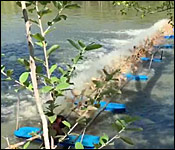
 For several weeks now, we've been showing you the severity of the pollution in the New River in the Orange Walk District. According to residents who have lived near it for many years, the river is the worst they have ever seen it.
For several weeks now, we've been showing you the severity of the pollution in the New River in the Orange Walk District. According to residents who have lived near it for many years, the river is the worst they have ever seen it.
The effects of the pollution are currently being felt all across the riverside communities, and currently, the most well-known impact is the problem it is causing for the over one thousand students at La Inmaculada Primary School in Orange Walk Town. The school had to close last week Thursday because of the noxious smell and it still isn't opened today.
They are currently considering whether or not they will have temporarily relocate the school in response to this public health threat, and we'll tell you what's the latest with that situation. We start first, however, with the plan that the Department of Environment is employing to try and reverse the effects of the pollution.
We're told that for the river to return to a healthier state, it will take years to rehabilitate. But, the DOE is taking that first step by installing aerators in one part of the New River. They want to see if this corrective measure will yield positive results before they roll it out to other parts. Our news team was in Orange Walk Town today to observe that process, and Daniel Ortiz learned more about it. Here's his report:
Daniel Ortiz reporting
These spinning devices, which you see in the middle of the New River, are called aerators. Their purpose is to pump oxygen back into the water so that its pollution damage can start to be reversed. The Department of Environment is literally attempting to breathe life back into the river, since dissolved oxygen is needed to sustain aquatic animals, and the pollution depleted most of its oxygen stores.
 Edgar Ek - Deputy Chief Environmental Officer, DOE
Edgar Ek - Deputy Chief Environmental Officer, DOE
"We're going to install some aerators. This is basically to introduce oxygen into the water because right now, it's almost depleted, if not depleted. So, what that will do is to help in changing that situation."
"So what the aerators do is that it spins, it moves the water, and that's how oxygen is introduced into the water column. It brings everything from the bottom, up to 5 feet, I think those particular ones. And then, it starts to introduce oxygen."
But, the most immediate concern right now for those living near the riverbanks is the foul stench of dead fish and other flora and fauna that once called the river home.
Edgar Ek
"It will help with the smell that we are having right now, the release of other toxic substances like H2S, and also prevent the condition from being anaerobic."
Reporter
"Hydrogen sulfide is what you're referring to, right?"
Edgar Ek
"Exactly, hydrogen sulfide."
Reporter
"And that's what's causing the smell?"
Edgar Ek
"It's not only that. It different chemicals that are being released, because, during the anaerobic process, chemical substances like methane and hydrogen sulfide are being released. How do you detect hydrogen sulfide, you'll have a rotten egg smell."
That rotten egg smell from the hydrogen sulfide in the river is not only an unbearable nuisance. At high concentrations, it can actually be very harmful to human health:
Edgar Ek
"At very low levels, you'll start to smell it. Less than 1 part per million, you'll start to smell that rotten egg smell. Once you reach up, I think less than 100 parts per million, you'll have some minor effects on humans, like irritation to the throat, nausea, irritation to the eyes - thing like that. But, other segments of the population might be more susceptible to it. For example, those that suffer from asthma, because it causes the closure of the bronchioles. So, some situations like that will happen. But, from the information that we have right now, we are not reaching that level. Once you reach like 500 parts per million, then it's where you need to be concerned because, at that point in time, there is no smell, the concentration is higher. And then, you could have seizures and death within hours."
At this moment, the DOE personnel is running a pilot project with these aerators at El Gran Mestizo Resort, which is the home of Maracas Bar and Grill Restaurant in the Orange Walk. It's located at a part of the New River that is most negatively impacted by water pollution. The aerators are expected to stir up the hydrogen sulfide in the river, which will help, but like any sickness, the symptoms have to get worse before it gets better. So, the DOE wants to test how much of the harmful gas will be released once the aerators are activated.
Edgar Ek - Deputy Chief Environmental Officer, DOE
"Whatsoever, it doesn't have to be the aerators. It could be other methodologies that we might introduce. There will be a phase where the situation will deteriorate. That's supposed to be short-lived, We're not expecting that it's going to extend for a long period. And after that, it should - if things work out as we expect, then it should turn out to be normal."
"Like I said, it's a trial. We want to be sure these are going to work, and we are going to measure water quality prior to the installation of this, continue to measure during the process. Along with it, we're going to measure the possible impacts, particularly H2S releases."
"The equipment that we have here right now, we have the sensors, the H2S sensors. There's a control in there. There are, I think, 3 sensors that are being placed around this area. Once it reaches a threshold, in this case, I think it's 8 parts per million, it sends a signal to the main control, and then, there's a light that starts to blink. That indicates to us that we're approaching very sensible levels in terms of mild impacts on humans. And I think the next alarm will come at or after 10 parts per million when it will start to emit a sound. And then, you should be more careful, in terms of putting masks and stuff like that."
Should the DOE personnel observe improvements in this testing area, then aerators will be installed at strategic points along the river, where the pollution effects are highest.
Edgar Ek
"If we realize that things are improving in the river, in terms of using aerators, then we will start to install them, little by little, on a gradual basis, along the stretch of the impacted area."
"I just want to also caution people that use the river to be mindful of the equipment that we have in there. We don't want any accident to happen as well."
Of importance is residents have observed that animals are still dying in the river. This picture of an adult crocodile was taken several days ago and shows how this top apex predator in the environment has perished as a consequence of the pollution.



